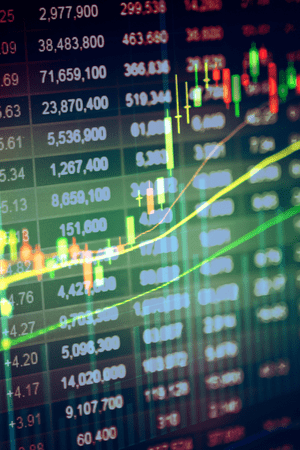The bond prices
There are three ways to determine the value of bonds: by price, yield or spread. In this article, we will take you through how the price of a bond is determined.
Because government bonds and corporate bonds are traded on the stock exchange, the price is initially determined by supply and demand. But how do traders determine what a fair price is for a bond? This depends on several factors.
In order to understand these factors, it is first important to understand that the trading price of a bond is not expressed in euros or dollars, for example, but in a percentage. Suppose a country or a company issues a bond of 1,000 euros, then that security has a value of 100 percent at the time of issue. If the issued bond is popular with traders, then the price can increase in percentage terms. Suppose that the bond can be traded for 4 percent more at a certain time, then that is equivalent to a price of 104 percent. On the other hand, a bond can also fall below the 100 percent threshold.
An important factor in determining the price of bonds is the interest rate that is linked to the current economic situation in a country or company. If the economy is doing well, in most cases the interest rate will also rise. In an economic crisis, the opposite usually happens. In addition, local inflation and the monetary policy of central banks are important indicators that determine the level of the interest rate. If a sharp increase in inflation is expected, this will usually also lead to rising interest rates.
Rising interest rates have a depressing effect on the price of bonds. The simple reason for this is that newly issued bonds are linked to the higher interest rate, which means that older bonds, because of their lower interest rates, start to fall out of favor with traders and can therefore only be traded at a lower price.

Of course, you are not obliged to sell your low-interest bonds when new ones with higher interest rates are issued. You can also choose to simply keep them in your possession, so that you continue to receive the predetermined interest during the term and at the end of the term you are paid the nominal value of the bond.
Pricing of corporate bonds
When buying and selling corporate bonds, there are a few other aspects that come into play that determine the value of a bond, in addition to the factors described above.
An important indicator in this case is the company’s cash flow. How high is the net debt burden and does the company have sufficient cash to continue to meet its repayment obligations? These types of specific credit ratings are drawn up by specialist agencies, such as Fitch, Moody’s and Standard & Poor’s. They draw up a profile based on the available financial data of a company, from which investors can determine the risk to be taken. The higher the estimated business risk, the higher the interest rate on a bond will have to be in that case in order to be found attractive by market parties.
Compare brokers and start investing in bonds
Are you excited about investing in bonds after reading this article? Check out brokers that offer bonds and find the broker that suits you best!